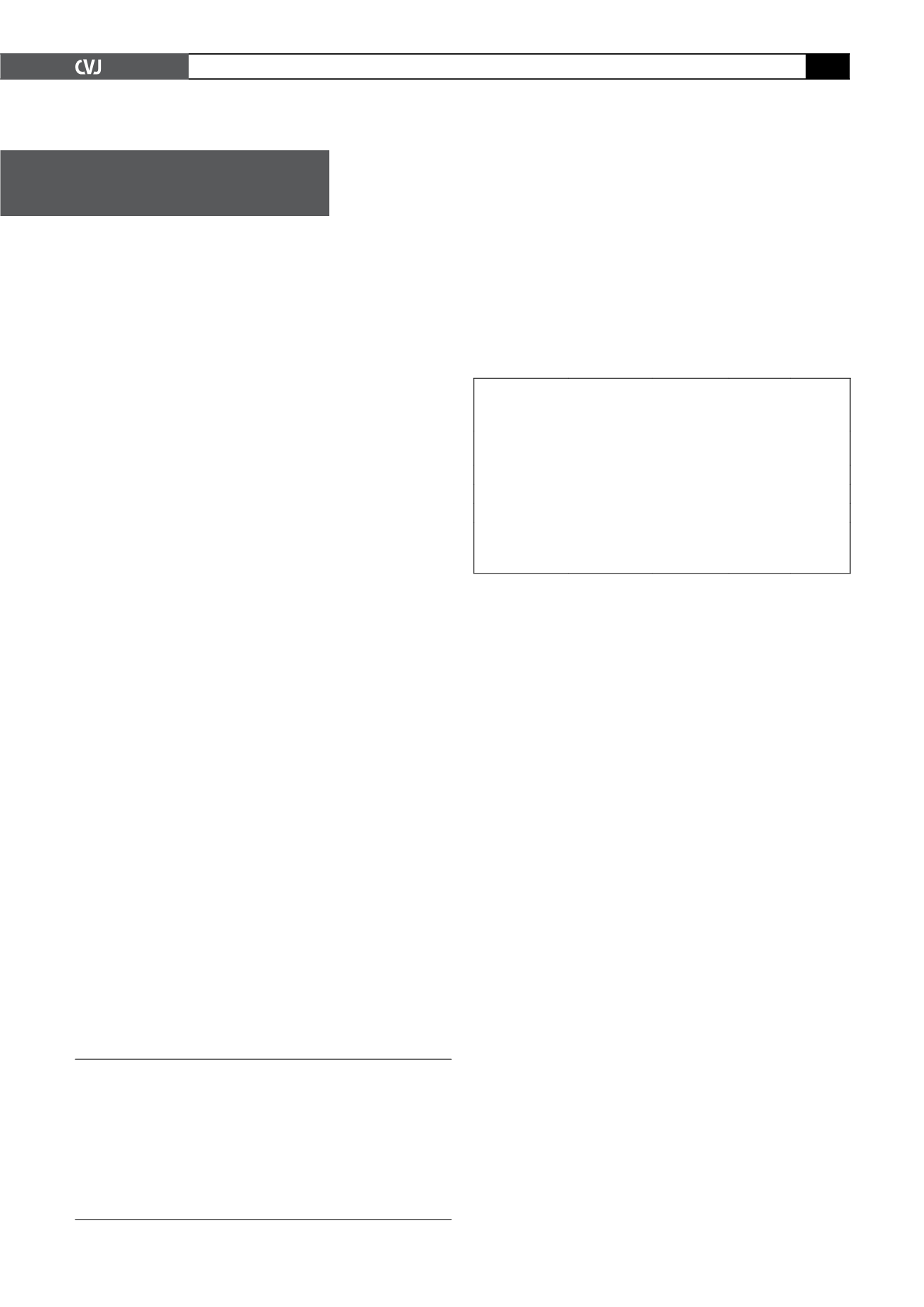
CARDIOVASCULAR JOURNAL OF AFRICA • Vol 21, No 1, January/February 2010
AFRICA
47
Case Report
Persistently elevated CKMB and negative troponin T in a
patient at ischaemic risk with chest pain
D SCHULENBURG, W DE LANGE, H VAN JAARSVELD, JM KUYL
Summary
Analytical interference in laboratory assays is not only
unpredictable but also an underestimated problem. Not
recognising these interferences can lead to misdiagnosis and
mismanagement of patients. We present a case of a patient
with chest pain and ischaemic risk factors with incongruent
biochemical results. These results were discovered to be due
to the presence of macro-creatine kinase (macro-CK)
in vivo
interfering with the CKMB activity assay.
Keywords:
analytical interference, assay interference, macro-
creatine kinase, creatine kinase interference
Submitted 23/1/09, accepted 9/6/09
Cardiovasc J Afr
2010;
21
: 47–48
Case report
A 55-year-old female patient, previously diagnosed with biven-
tricular cardiac failure, was admitted to the high-care ward at
Universitas Hospital for optimisation of her anti-failure treat-
ment. The left-sided cardiac failure was due to longstanding,
poorly controlled hypertension, while the right-sided cardiac
failure was secondary to the left-sided failure and obstructive
sleep apnoea.
On day four of the admission she developed severe central
chest pain. Her risk factors for ischaemic heart disease included:
obesity class III (BMI
=
54 kg/m
2
), hypertension, hypercholes-
terolaemia and obstructive sleep apnoea.
The initial troponin T assay (Roche Elecsys 2010) was nega-
tive (
<
0.03 ng/ml) but the total creatine kinase (CK) and CKMB
activity (Beckman Coulter LX-20) was raised to 403 U/l (26–140
U/l) and 435 U/l (
<
24 U/l), respectively, resulting in a CKMB
percentage of
>
100% (
<
6%). The ECG showed no evidence
of myocardial ischaemia. Cardiology was consulted and it was
decided that the cardiac markers be repeated six, 12 and 24 hours
later. Repeat biochemical analysis demonstrated the same incon-
gruent cardiac marker pattern (Table 1).
The persistent nature of the raised CKMB activity led us
to suspect that interference was responsible for these results.
Re-analysis of dilutions of the samples resulted in non-linear
results. Non-linearity in immunoassays generally points to the
presence of assay interference although it does not identify the
source. We then treated the specimen with polyethylene glycol
(PEG) according to a published operating procedure.
1
When PEG is added to a sample, proteins are excluded from
areas in the sample occupied by PEG, raising their concentration
in the remaining sample area until precipitation of the proteins
occurs. Although various factors play a role, larger proteins are
more prone to precipitation than smaller proteins at a given
PEG concentration. Therefore PEG has been used to precipitate
immune complexes from serum samples.
In our patient’s sample, 60% of the CK activity was precipitat-
ed by PEG, which raised the possibility of the presence of macro-
CK. As our assay has not been validated for the use of PEG, we
used this to increase our index of suspicion only.
1
We confirmed
macro-CK as the interfering compound with the reference method
gel filtration chromatography (GFC). GFC is a separation meth-
od based on molecular weight (i.e. size exclusion principles).
GFC demonstrated that macro-CK contributed 62.7% to the
total CK activity and that the free CK (134 U/l) was well within
the normal population reference interval (
<
167 U/l) (Fig. 1).
Discussion
Macro-CK is a macro-molecular form of CK that forms and
circulates
in vivo
. The macro-molecules are either CK molecules
forming complexes with immunoglobulins (macro-CK type 1)
or mitochondrial CK polymers (macro-CK type 2). The most
common macro-CK type 1 described is a CK BB-IgG complex.
It has been observed in a variety of clinical conditions, as well
as in apparently healthy individuals, but no clear correlation has
been demonstrated.
2
Macro-CK type 2, being a mitochondrial
polymer, is found predominantly in severely ill patients suffering
Department of Chemical Pathology, Universitas National
Health Laboratory Services, University of the Free State,
Bloemfontein, South Africa
D SCHULENBURG, MMed (Chem Path)
H VAN JAARSVELD, PhD
JM KUYL, FF Path (SA)
Department of Internal Medicine, University of the Free
State, Bloemfontein, South Africa
W DE LANGE, MMed (Int Med),
TABLE 1. BIOCHEMICAL RESULTS
DEMONSTRATINGTHE PERSISTENT NATURE
OF THE ELEVATED CKMB FRACTION
Troponin T
(
<
0.03 ng/ml)
Total CK
(26–140 U/l)
CKMB
(
<
24 U/l)
% CKMB
(
<
6%)
Index day
<
0.03
403
435
>
100
Four hours later
<
0.03
393
448
>
100
Following day
<
0.03
376
291
77
Two-week clinic
follow up after
discharge
308
268
87


